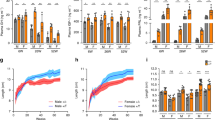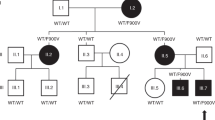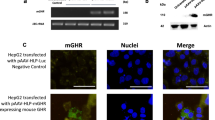Abstract
Combined pituitary hormone deficiency (CPHD) in man denotes impaired production of growth hormone (GH) and one or more of the other five anterior pituitary hormones. Mutations of the pituitary transcription factor gene POU1F1 (the human homologue of mouse Pit1) are responsible for deficiencies of GH, prolactin and thyroid stimulating hormone (TSH) in Snell and Jackson dwarf mice and in man, while the production of adrenocorticotrophic hormone (ACTH), luteiniz-ing hormone (LH) and follicle stimulating hormone (FSH) is preserved. The Ames dwarf (df) mouse displays a similar phenotype, and appears to be epistatic to Snell and Jackson dwarfism. We have recently positionally cloned the putative Ames dwarf gene Prop1 (ref. 1)f which encodes a paired-like homeodomain protein that is expressed specifically in embryonic pituitary and is necessary for Pit1 expression. In this report we have identified four CPHD families with homozy-gosity or compound heterozygosity for inactivating mutations of PROP1. These mutations in the human PROP1 gene result in a gene product with reduced DNA-binding and transcriptional activation ability in comparison to the product of the murine df mutation. In contrast to individuals with POU1F1 mutations, those with PROP1 mutations cannot produce LH and FSH at a sufficient level and do not enter puberty spontaneously. Our results identify a major cause of CPHD in humans and suggest a direct or indirect role for PROP1 in the ontogenesis of pituitary gonadotropes, as well as somatotropes, lactotropes and caudomedial thyrotropes.
This is a preview of subscription content, access via your institution
Access options
Subscribe to this journal
Receive 12 print issues and online access
$209.00 per year
only $17.42 per issue
Buy this article
- Purchase on Springer Link
- Instant access to full article PDF
Prices may be subject to local taxes which are calculated during checkout
Similar content being viewed by others
References
Sornson, M.W. et al Pituitary lineage determination by the Prophet of Pit-1 homeodomain factor defective in Ames dwarfism Nature 384, 327–333 (1996).
Raskin, S. et al. Genetic mapping of the human pituitary-specific transcriptional factor gene and its analysis in familial panhypopituitary dwarfism. Hum. Genet. 98, 703–705 (1996).
Bartke, A. The response of two types of dwarf mice to growth hormone, thyrotropin, and thyroxine. Gen. Comp. Endocrinol. 5, 418–426 (1965).
Bartke, A. Genetic models in the study of anterior pituitary hormones, in Genetic Variation in hormone system (ed. Shire, J.) 111-126 (CRC Press, Boca Raton, 1979).
Buckwalter, M.S., Katz, R.W. & Camper, S.A. Localization of the panhypopituitary dwarf mutation (df) on mouse chromosome 11 in an intersubspecific backcross. Genomics 10, 515–526 (1991).
Gage, P.J., Lossie, A.C., Scarlett, L.M., Lloyd, R.V. & Camper, S.A. Ames dwarf mice exhibit somatotrope commitment but lack growth hormone- releasing factor response. Endocrinology 136, 1161–1167 (1995).
Gage, P.J., Roller, M.L., Saunders, T.L., Scarlett, L.M. & Camper, S.A. Anterior pituitary cells defective in the cell-autonomous factor, df, undergo cell lineage specification but not expansion. Development 122, 151–160 (1996).
Kappen, C., Schughart, K. & Ruddle, F.H. Early evolutionary origin of major homeodomain sequence classes. Genomics 18, 54–70 (1993).
Andersen, B. et al. The Ames dwarf gene is required for Pit-1 gene activation. Dev. Biol. 172, 495–503 (1995).
Tang, K., Bartke, A., Gardiner, C.S., Wagner, T.E. & Yun, J.S. Gonadotropin secretion, synthesis, and gene expression in human growth hormone transgenic mice and in Ames dwarf mice. Endocrinology 132, 2518–2524 (1993).
Pf¨affle, R.W. et al. Mutation of the POU-specific domain of Pit-1 and hypopituitarism without pituitary hypoplasia. Science 257, 1118–1121 (1992).
Cohen, L.E. et al. A ”hot spot“ in the Pit-1 gene responsible for combined pituitary hormone deficiency: clinical and molecular correlates. J. Clin. Endocrinol. Metab. 80, 679–684 (1995).
Tatsumi, K. et al. Cretinism with combined hormone deficiency caused by a mutation in the PIT1 gene. Nature Genet. 1, 56–58 (1992).
Author information
Authors and Affiliations
Rights and permissions
About this article
Cite this article
Wu, W., Cogan, J., Pfäffle, R. et al. Mutations in PROP1 cause familial combined pituitary hormone deficiency. Nat Genet 18, 147–149 (1998). https://doi.org/10.1038/ng0298-147
Received:
Accepted:
Issue Date:
DOI: https://doi.org/10.1038/ng0298-147
This article is cited by
-
Comparison of clinical characteristics of a pediatric cohort with combined pituitary hormone deficiency caused by mutation of the PROP1 gene or of other origins
Hormones (2024)
-
Adrenal insufficiency
Nature Reviews Disease Primers (2021)
-
Intronic variant in POU1F1 associated with canine pituitary dwarfism
Human Genetics (2021)
-
Growth hormone — past, present and future
Nature Reviews Endocrinology (2018)



